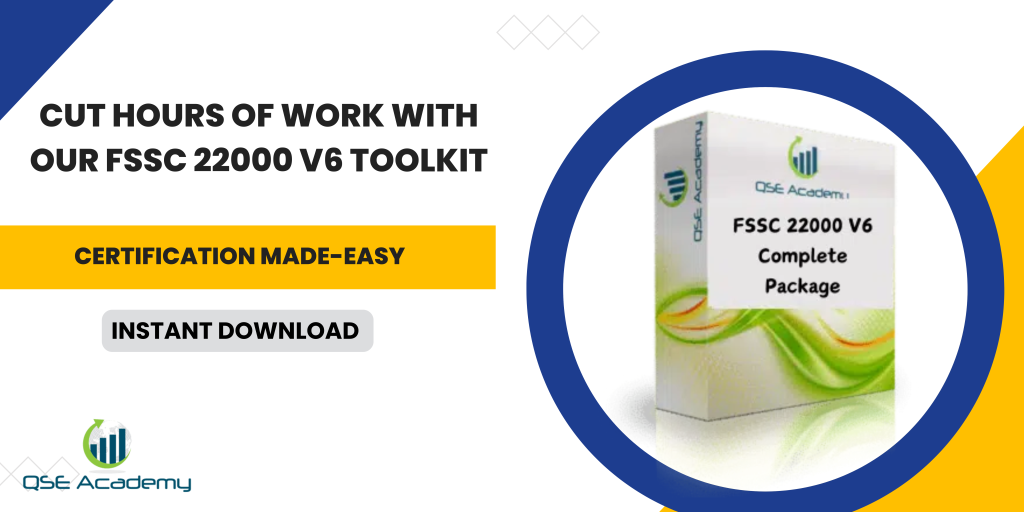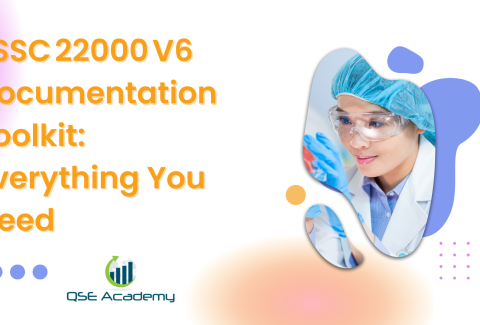FSSC 22000 V6 Requirements: Scheme Components Explained
Making the FSSC 22000 V6 Structure Clear and Practical
If you’ve ever opened the FSSC 22000 documentation and wondered how ISO 22000, PRPs, and Additional Requirements are supposed to fit together, you’re not alone. Many organizations understand the pieces individually, but struggle to see how they connect into a single structured certification system.
At QSE Academy, we’ve supported companies across food manufacturing, packaging, distribution, and logistics with FSSC 22000 implementation. Something we consistently observe is that once the structure becomes clear, implementation gets faster, more logical, and far easier to sustain.
This guide breaks down the FSSC 22000 Version 6 scheme into its core components. By the end, you’ll understand exactly how the scheme is structured, what’s required, where the major effort sits, and how compliance aligns across the system.
Overview of the FSSC Scheme Structure — How the Components Fit Together
The FSSC 22000 V6 scheme isn’t one single document — it’s a combination of four elements working together:
- ISO 22000:2018 — the Food Safety Management System framework
- Sector-Specific PRPs (ISO/TS 22002 series or equivalent) — operational hygiene controls
- FSSC Additional Requirements (Part 2) — mandatory requirements beyond ISO 22000
- Certification Process and Governance Requirements (Part 3) — rules for audits and certification cycles
A simple way to think about it:
| Layer | Purpose |
|---|---|
| ISO 22000 | Management framework, risk management, HACCP |
| PRPs (ISO/TS 22002) | Operational hygiene requirements |
| Additional Requirements | Controls not fully covered by the above |
| Governance Rules | How certification bodies must audit compliance |
Pro Tip: Treat these layers as one integrated system — not separate programs.
 ISO 22000:2018 — The Core Management System Requirement
ISO 22000:2018 — The Core Management System Requirement
ISO 22000 forms the backbone of the entire FSSC certification. It defines how the Food Safety Management System (FSMS) operates, including:
- Leadership, roles, and accountability
- Risk-based thinking and planning
- Communication and documentation
- Hazard analysis using HACCP principles
- Operational controls and monitoring
- Internal audits, performance evaluation, and continual improvement
ISO 22000 applies the Plan-Do-Check-Act (PDCA) model twice — once at the management level and once at the operational control level. This structure ensures the system isn’t static — it evolves with risks, performance, and feedback.
Pro Tip: Ensure ISO 22000 is fully implemented and functioning before layering in the additional FSSC components.
PRP Requirements — ISO/TS 22002 Series and Industry Scopes
Prerequisite Programs (PRPs) establish baseline hygiene and operational control. FSSC 22000 requires PRPs based on sector-specific modules, such as:
| PRP Module | Sector |
|---|---|
| ISO/TS 22002-1 | Food manufacturing |
| ISO/TS 22002-2 | Catering |
| ISO/TS 22002-3 | Farming |
| ISO/TS 22002-4 | Food packaging manufacturing |
| ISO/TS 22002-5 | Transport and storage |
| ISO/TS 22002-6 | Feed and pet food |
| PAS publications | Used where no ISO module exists |
PRPs cover areas such as:
- Facility layout and zoning
- Cleaning and sanitation
- Pest control
- Allergen management
- Storage and transport hygiene
- Equipment maintenance
- Personnel hygiene
Pro Tip: Match the correct PRP standard to your certification scope — misalignment is a common cause of audit findings.
FSSC 22000 V6 Additional Requirements — The Mandatory Enhancements
Version 6 introduced strengthened expectations in areas not fully covered by ISO 22000 or PRPs.
These include:
- Supplier and service management
- Allergen labeling and control
- Food defense
- Vulnerability assessment and food fraud prevention
- Environmental monitoring
- Food safety and quality culture
- Management of waste and water
- Packaging control
- Calibration and equipment verification
These requirements are not optional. They carry the same weight as ISO 22000 clauses during certification.
Pro Tip: Develop a clear matrix showing how each Additional Requirement is addressed — auditors appreciate transparency and traceability.
Food-Safety Culture — The Human Behavior Component
FSSC 22000 V6 emphasizes that food safety isn’t only technical — it depends on people. Culture is now a measurable requirement, meaning organizations must demonstrate consistent:
- Leadership engagement
- Effective communication
- Training with demonstrated competence
- Accountability and follow-through
- Employee involvement and feedback
One company we supported introduced short weekly reminders linked to real production challenges. Within a few months, employee reporting increased and recurring hygiene deviations significantly dropped — not because procedures changed, but because people did.
Sector Scopes and Category Requirements — Understanding Where You Fit
The FSSC scheme assigns certification scopes based on activity. These range from food manufacturing to feed, packaging, and logistics.
Each category has specific requirements tied to:
- PRP module selection
- operational hygiene controls
- audit scope and duration
- documented evidence expectations
Pro Tip: Ensure your declared scope aligns with actual operations — mismatch leads to major non-conformities.
Certification Process Requirements — How Compliance Is Evaluated
The certification process follows strict rules defined in Part 3 of the scheme, including:
- Stage 1 and Stage 2 audits
- Audit duration rules
- Handling of non-conformities
- Surveillance audits
- Recertification cycles
- Requirements for unannounced audits
- Witness and reporting expectations for certification bodies
Pro Tip: Treat certification as an ongoing commitment rather than a checkpoint event — auditors expect consistency, not preparation.
Documentation and Evidence Requirements Across the Scheme
To demonstrate compliance, organizations must maintain documented:
- Policies and procedures
- Records for monitoring and verification
- Hazard and risk assessments
- Training and competency evidence
- Supplier evaluations
- Environmental and operational logs
- Internal audit and management review outputs
Pro Tip: Keep documentation structured, consistent, and directly tied to defined controls — avoid unnecessary complexity.
FAQs — Common Questions When Implementing FSSC 22000 V6
Q1: Is ISO 22000 certification enough to achieve FSSC certification?
No — ISO 22000 is only one part of the scheme. PRPs and Additional Requirements are also mandatory.
Q2: Which component takes the most time to implement?
Most organizations require focused effort on Additional Requirements and evidence of consistent application.
Q3: Can outsourced transport or storage be excluded?
No — if it affects product safety, it must be controlled and verified.
Conclusion — Bringing the Scheme Together
Understanding the structure of the FSSC 22000 V6 scheme is often the turning point in implementation.
Once the components are clear — ISO 22000, PRPs, Additional Requirements, and certification rules — building a compliant FSMS becomes systematic and achievable.
If you’re working toward certification or improving system performance, the next step is ensuring each requirement is implemented, verified, and maintained consistently.
Melissa Lavaro is a seasoned ISO consultant and an enthusiastic advocate for quality management standards. With a rich experience in conducting audits and providing consultancy services, Melissa specializes in helping organizations implement and adapt to ISO standards. Her passion for quality management is evident in her hands-on approach and deep understanding of the regulatory frameworks. Melissa’s expertise and energetic commitment make her a sought-after consultant, dedicated to elevating organizational compliance and performance through practical, insightful guidance.








